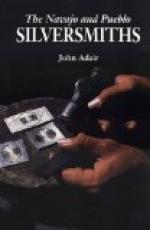A forge built in an outhouse on my own premises by an Indian silversmith, whom I employed to work where I could constantly observe him, was twenty-three inches long, sixteen inches broad, five inches in height to the edge of the fire-place, and the latter, which was bowl-shaped, was eight inches in diameter and three inches deep. No other Navajo forge that I have seen differed materially in size or shape from this. The Indian thus constructed it: In the first place, he obtained a few straight sticks—four would have sufficed—and laid them on the ground to form a frame or curb; then he prepared some mud, with which he filled the frame, and which he piled up two inches above the latter, leaving the depression for the fire-place. Before the structure of mud was completed he laid in it the wooden nozzle of the bellows, where it was to remain, with one end about six inches from the fire-place, and the other end projecting about the same distance beyond the frame; then he stuck into the nozzle a round piece of wood, which reached from the nozzle to the fire-place, and when the mud work was finished the stick was withdrawn, leaving an uninflammable tweer. When the structure of mud was completed a flat rock about four inches thick was laid on at the head of the forge—the end next to the bellows—to form a back to the fire, and lastly the bellows was tied on to the nozzle, which, as mentioned above, was built into the forge, with a portion projecting to receive the bellows. The task of constructing this forge did not occupy more than an hour.
[Illustration: Pl. XVI. Objects in silver.]
A bellows, of the kind most commonly used, consists of a tube or bag of goatskin, about twelve inches in length and about ten inches in diameter, tied at one end to its nozzle and nailed at the other to a circular disk of wood, in which is the valve. This disk has two arms: one above for a handle and the other below for a support. Two or more rings or hoops of wood are placed in the skin-tube to keep it distended, while the tube is constricted between the hoops with buckskin thongs, and thus divided into a number of compartments, as shown in Pl. XVII. The nozzle is made of four pieces of wood tied together and rounded on the outside so as to




